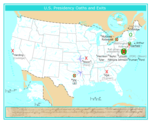PartyVotes-Presidents.png


|
This
graph
image could be re-created
using
vector graphics
as an
SVG
file
. This has several advantages; see
Commons:Media for cleanup
for more information. If an SVG form of this image is available, please upload it and afterwards replace this template with
{{
vector version available
|
new image name
}}
.
It is recommended to name the SVG file “PartyVotes-Presidents.svg”—then the template Vector version available (or Vva ) does not need the new image name parameter. |
Summary
| Description PartyVotes-Presidents.png |
English:
This graph shows the popular vote of political parties in
United States presidential elections
. The boxes which contain the year are colored in according to which party won
the presidency
that year. Criteria for inclusion: Party must have either won the presidency or have gotten more than 25% of the popular vote.
The name of the person who won the election and became president is listed, with a gray arrow pointing to the name of a person who became president without having been elected as president (9 total of these transitions happening prior to term completion). The double arrow indicates becoming president without having been elected as vice president as well ( Ford ). 5 other vice presidents who became president are underlined in black (14 total). Of these 14, only 5 were elected directly into the presidency (with 2 of these achieving re-election), with the other 9 filling a vacancy (8 due to death, 1 due to resignation). Of these 9, re-election was achieved by 4. Nixon is unique in that he is the only one to become president with a gap after having left the office of Vice President. Ford is unique in that he was never elected as either President or vice president. (This was identified as a factor in him losing his bid for re-election.) The black squares for the 1800 and 1824 indicate that the presidency was achieved after a tie in the electoral vote in the first case ( Jefferson ), and without having a majority of electoral votes in the second case ( J.Q. Adams ). In that 1824 election, four candidates from the same party (Democratic-Republican) were voted on. A blue star is shown in five elections: 1824 , 1876 , 1888 , 2000 , and 2016 . These are cases where the presidency was achieved without having a plurality of the popular vote (these cases are also indicated with a double thick border around the year of that election). The reason why all of these four stars are color-coded blue is because in the latter three cases, the party receiving the plurality of popular votes was Democratic, and while the 1824 case had Andrew Jackson in the Democratic-Republican Party receiving the plurality of votes, this event led to the creation of the Democratic Party in which Jackson won the presidency in the very next election ( 1828 ). The letter 'H' indicates that the election was decided by the House of Representatives (Jefferson & J.Q. Adams), and the letter 'S' indicates that the election was finalized by the Supreme Court ( G.W. Bush ). While the process of a presidential election being decided by the House is specifically enumerated by the Constitution, there is no such power given to the Supreme Court. The Supreme Court has no authority , per se , to decide a presidential election. Its finalization of Bush was a result of their Constitutional authority to rule over a court case ( Bush v. Gore ), and it is only because the election was so close (with a margin of victory of hundreds of votes in a state where almost 6 million votes were cast) that the ruling of 9 justices had the de facto effect of Bush being elected as president. (And since their decision had a 5-4 split, it made for the extremely improbable case where any single justice who voted in the majority had the power to swing the ruling, so this decision on whether Bush would win the election rested on a single person.) The asterisk next to Lincoln's name in 1864 is because for that wartime election, the Republican Party chose to call themselves the National Union Party. The 'Ø' symbol in 1820 indicates that there was no Federalist candidate that ran against Monroe (but still got more than 16% of the popular vote). This graph starts at 1788 , and does not address the persons who performed the presidential roles (including Head of State, Executive in Chief and Commander in Chief) under previous governments of the United States of America, under the Articles of Confederation and prior to the 1781 ratification of that first written constitution for the country. The top line of this graph has Roman numerals to indicate the election number (also term number), and the presidency numbers are shown as well (eg. Reagan -40th President). 
To see the control of the Executive Branch graphed in context with control of the House and Senate, see File:Combined--Control of the U.S. House of Representatives - Control of the U.S. Senate.png . 
For a map that shows where the nine pre-term completion vice-president transitions took place, see File:US Presidents Map of Oaths and Exits.png .
Data from 1788 to 1820 from
http://www.ourcampaigns.com/
|
| Date | |
| Source | File:PartyVotes.png |
| Author | ChrisnHouston |
| Other versions |
|
Licensing
|
|
This file is made available under the Creative Commons CC0 1.0 Universal Public Domain Dedication . |
|
The person who associated a work with this deed has dedicated the work to the
public domain
by waiving all of their rights to the work worldwide under copyright law, including all related and neighboring rights, to the extent allowed by law. You can copy, modify, distribute and perform the work, even for commercial purposes, all without asking permission.
http://creativecommons.org/publicdomain/zero/1.0/deed.en CC0 Creative Commons Zero, Public Domain Dedication false false |


